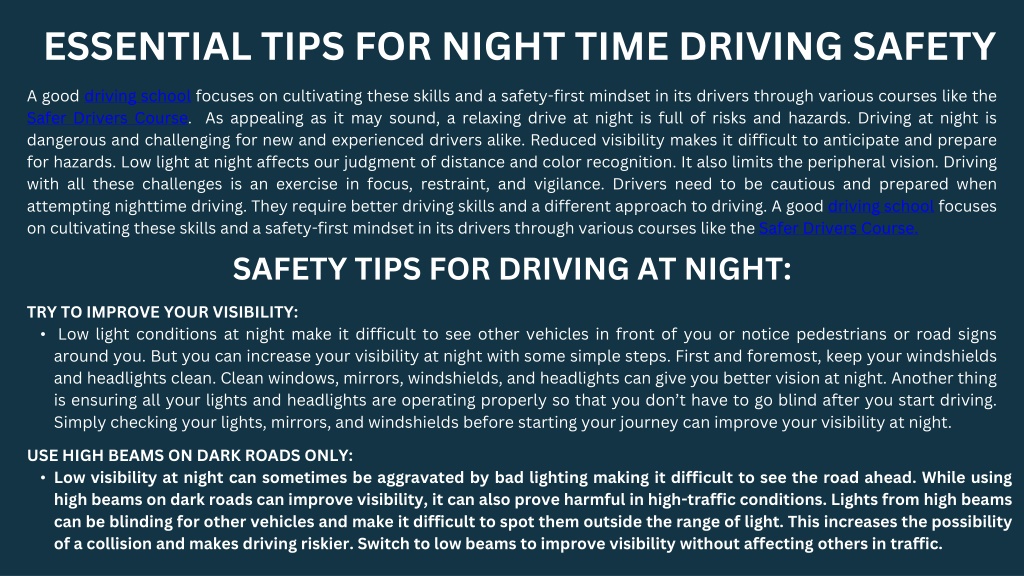Driving at Night for the First Time? Essential Tips for Safety
Driving at night can feel exhilarating, yet daunting, especially for those venturing behind the wheel for the first time. The roads transform as daylight fades, presenting a unique set of challenges that require heightened awareness and skill. However, with the right strategies, nighttime driving can become a safe and enjoyable experience. Here are essential tips to navigate those dimly lit roads confidently.
Understanding how vision works at night is vital. Naturally, our eyesight diminishes in low-light conditions. This reduction in visibility can obscure obstacles, traffic signals, and even pedestrians. Therefore, it’s important to adjust your driving approach as the sun sets. Utilizing your vehicle’s headlights properly is the first step towards ensuring your safety. Always switch on your headlights before dusk; this makes your car visible to others. Additionally, be sure your headlights are properly aligned—misaligned headlights can actually blind other drivers and reduce your own visibility.
Once the darkness falls, avoid the common temptation of over-relying on high beams. High beams enhance visibility on empty roads but can be a nuisance for oncoming traffic. Use high beams judiciously, only in areas devoid of streetlights and pedestrian traffic. When you spot another car approaching, switch back to low beams to allow the driver comfort and safety. Maintaining an awareness of your surroundings and adjusting your beams appropriately not only protects you but also fosters a community of safe drivers.
Maintaining a safe following distance is crucial when driving at night. In the glare of headlights or the shadows, it’s easy to misjudge distances. Increasing your following distance can provide the necessary reaction time if a vehicle suddenly brakes or an obstacle appears. A distance of at least three seconds can help ensure you have ample time to respond effectively to any unexpected situations.
It’s imperative to scan your environment regularly while driving. Look well beyond the road in front of you. As a newer driver, consider practicing techniques such as the “two-second rule,” which involves checking your surroundings every couple of seconds. This extends not just your line of sight, but also enhances your awareness of movement signs around your vehicle. Scan for pedestrians, wildlife, and road conditions. Watch for shadows or reflections that may hint at unexpected hazards.
In addition to enhancing your driving habits, the interior environment of your car contributes significantly to your driving comfort and focus. Use the dimmer for your dashboard lights. Overly bright displays can distract you from the road and impair your night vision. Moreover, avoid any distractions—whether it’s adjusting your playlist or attending to a text message. The fewer distractions you have, the more focused you can remain on the road ahead.
Weather conditions can further complicate nighttime driving. Rain, fog, and snow often reduce visibility and create slippery road conditions. If you find yourself driving in inclement weather, lower your speed and increase your following distance even further. Being cautious in these situations can mean the difference between a smooth ride and a perilous experience.
Finally, it’s essential to acknowledge that fatigue plays a significant role in nighttime driving risks. The body’s natural circadian rhythm often indicates that alertness dips in the late evening and early morning hours. It might be a good idea to avoid late-night driving if you’re feeling tired. Make it a priority to ensure you’re well-rested before embarking on a journey at night. If you feel drowsy while driving, pull over to a safe area and take a moment to rest. Power naps have proven effective for many drivers.
In conclusion, embarking on night driving for the first time can be an exhilarating yet challenging experience. By adhering to these essential safety tips—ensuring proper headlight usage, maintaining a safe distance, and being aware of your surroundings—you can navigate the dark with increased confidence. Make wise choices behind the wheel, stay focused, and you will transform your night driving adventures into safe and enjoyable journeys.
You May Also Like
Best Fish to Catch in Australia: A Guide for Anglers
Australia boasts an extraordinary diversity of fish species, making it …
Emily Bay Norfolk Island: A Hidden Gem in the Pacific
Emily Bay, a picturesque enclave nestled on the sun-kissed shores of …
Holidays on August 23: Global Festivities & Observances
August 23 is a date that carries a bouquet of cultural significance …





